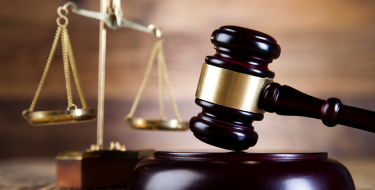Written By: Rhea Nayak, Juvenile Mental Health Fellow
Approximately 50 to 75% of the 2 million youth involved in the juvenile justice system meet the criteria for one or more mental health disorders (Gardner, 2011). However, once in corrective facilities, individuals struggle to gain access to the mental health services needed.
The primary goal of the juvenile justice system is the rehabilitation and treatment of minors. Whenever possible, the child’s family is involved throughout the process, which has been shown to improve outcomes for youth (Barnert et al., 2017). Additionally, minors attend educational programs while in juvenile correctional facilities, and courts tend to be more involved, regularly monitoring improvements (Bruno Law, n.d.).
Despite the many considerations, juvenile correctional facilities deeply affect a child’s physical and mental health. Youth incarceration has been correlated with poor general health outcomes, functional limitations, depressive symptoms, and suicidality in adulthood (Barnet et al., 2018). Time spent in a correctional facility can also create barriers to employment and higher education long after children are released (Juvenile Law Center, n.d.). Re-arrest rates are 75% within three years after leaving a juvenile correctional facility. This demonstrates that these systems, although they have been helpful to juveniles and their families, can be changed, in particular, to reduce these rates of recidivism for youth after they leave the system.
Juvenile Mental Health Courts (JMHCs) address high recidivism rates by utilizing a community and treatment-based approach tailored to a child’s specific mental health needs. Through Juvenile Mental Health Courts, mental health professionals utilize evidence-based therapy and rehabilitation-focused strategies for juveniles. JMHCs further create a support network through the court, including the judge and parole officers and the child’s family and community. The approach has led to remarkably reduced recidivism rates, or the tendency of a convicted juvenile to re-offend (Gardner, 2011). In Texas, the Harris County JMHC has a 59% reduction in recidivism compared to a detention center (Naqvi, 2023). Fort Bend has a 35% reduction, and Montgomery County has a 51% reduction (Naqvi, 2023).
Juvenile Mental Health Courts include rehabilitation, family involvement, special education services, reduced likelihood of recidivism, individualized court involvement, and personalized mental health treatments (Gardner, 2011). The average time a minor spends involved with a JMHC varies according to the nature of the mental disorder, but six to nine months was the most commonly reported time period (Callahan et al., 2012).
Juvenile Mental Health Courts in Texas typically have large minority populations, mainly African-American and Hispanic children, who tend to have limited access to mental health care. The specialized courts also offer treatment to children with multiple mental health disorders, but a few of the most common are substance abuse disorder, anxiety, ADHD, depression, and posttraumatic stress disorder (OJJDP, 2017).
While Juvenile Mental Health Courts are essential for children struggling with their mental health, it is essential to note mental illness does not increase one’s likelihood of committing crimes. Alternatively, certain mental health expressions are associated with the increased likelihood of misbehavior. Studies have found that externalizing disorders (including conduct disorders, oppositional defiant disorder, and antisocial disorder) and substance abuse disorders increase the likelihood of delinquency, violence, and involvement with the justice system. A study found that youth aggression and antisocial behavior was the strongest predictor for convictions in the future (Farrington, 1991). These two factors are most commonly expressed in externalizing disorders and, left untreated, can carry on to when the minors become adults (Liu, 2004). They also increase the likelihood for them to be re-arrested after leaving the juvenile court. (Barrett et al. 2014; Hawkins et al. 2000; Huizinga et al. 2000).
Juvenile Mental Health Courts are essential to treating children’s mental health concerns while balancing accountability and public safety. They provide evidence-based rehabilitation strategies to youths with mental illnesses, including for communities with diminished access to mental health care. Their continued success is evident through significantly lower recidivism rates than traditional juvenile detention centers.
Sources:
Callahan, L.,Cocozza, J., Steadman, H. J., Tillman, S., (2012, February 1). The authors are affiliated with the National Center for Mental Health and Juvenile Justice. A National Survey of U.S. Juvenile Mental Health Courts. Psychiatric Services.
https://ps.psychiatryonline.org/doi/full/10.1176/appi.ps.201100113
Heretick, Donna & Russell, Joseph. (2013). The Impact of Juvenile Mental Health Court on Recidivism among Youth. Journal of Juvenile Justice. 3. 1-14.
Intersection between Mental Health and the Juvenile Justice System . (2017, July). Office of Juvenile Justice and Delinquency Prevention.
https://ojjdp.ojp.gov/model-programs-guide/literature-reviews/intsection_between_mental_healt h_and_the_juvenile_justice_system.pdf
Hogg Foundation for Mental Health. (2021, January 13). Texas Juvenile Justice Department. https://hogg.utexas.edu/texas-juvenile-justice-department#:~:text=Re%2Darrest%20rates%20of %20youth,within%20a%20juvenile%20justice%20facility
Gardner, P. (2011, September 1). An Overview of Juvenile Mental Health Courts. American Bar Association.
https://www.americanbar.org/groups/public_interest/child_law/resources/child_law_practiceonli ne/child_law_practice/vol30/september_2011/an_overview_of_juvenilementalhealthcourts/
Youth in the Justice System: An Overview. Juvenile Law Center. (n.d.).
https://jlc.org/youth-justice-system-overview#:~:text=In%20lieu%20of%20prison%2C%20juven ile,routinely%20imposing%20correctional%20practices%20such
Naqvi, S. (2023). Analyzing the Outcomes of Juvenile Mental Health Courts in Texas Research Proposal.
Mental Health Courts. Texas Judicial Commission on Mental Health. (n.d.). https://texasjcmh.gov/technical-assistance/mental-health-courts/
Bruno Law (n.d.). 10 Differences Between Adult and Juvenile Criminal Court. https://brunolaw.com/resources/general-criminal-law/10-differences-between-adult-and-juvenile-criminal-court#:~:text=The%20system%20in%20juvenile%20court,education%20rather%20than%20just%20punishment.
Farrington (1991). Childhood aggression and adult violence: Early Precursors and Later-Life Outcomes. In: Pepler DJ, Rubin KH, editors. The Development and Treatment of Childhood Aggression. Hillsdale, NJ: Lawrence Erlbaum; pp. 5–29.
Liu J. (2004). Childhood Externalizing Behavior: Theory and
Implications. Journal of Child and Adolescent Psychiatric Nursing : Official Publication of The Association of Child and Adolescent Psychiatric Nurses, Inc, 17(3), 93–103. https://doi.org/10.1111/j.1744-6171.2004.tb00003.x
Barnert, E. S., Dudovitz, R., Nelson, B. B., Coker, T. R., Biely, C., Li, N., & Chung, P. J. (2017). How Does Incarcerating Young People Affect Their Adult Health Outcomes?. Pediatrics, 139(2), e20162624. https://doi.org/10.1542/peds.2016-2624




